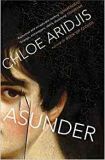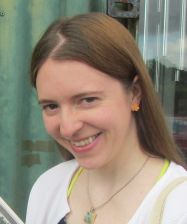Asunder by Chloe Aridjis
| Asunder by Chloe Aridjis | |
|
| |
| Category: Literary Fiction | |
| Reviewer: Rebecca Foster | |
| Summary: This is one of those very beautiful novels where very little seems to happen. Marie is a National Gallery guard, following in the footsteps of her great-grandfather, who was on duty in 1914 when a suffragette vandalised a painting. Aridjis ponders art, decay and the traces ordinary people leave behind. | |
| Buy? Yes | Borrow? Yes |
| Pages: 208 | Date: November 2014 |
| Publisher: Vintage | |
| External links: Author's website | |
| ISBN: | |
|
| |
Marie, the narrator of Chloe Aridjis's second novel, Asunder, is a guard at the National Gallery in London. It is a simple, subdued life she leads in this 'tiny kingdom', but it suits her: 'I had always sought quiet in the world and there were few movements quieter, I realised, than paint cracking over time.' Most would find her work tedious, but over her nine years at the museum she has adjusted to the routine; 'unlike some of the new guards, I do not suffer from boredom or listlessness.'
Few events disturb the rhythm of Marie's days. Even the death by heart attack of a sixty-something colleague induces little unrest. Soon the only vestige of him is a name engraved on a plaque commemorating those who died in service. Likewise, a climactic event from 1914, when Marie's great-grandfather Ted was a guard, has faded to the smallest trace. One day suffragette Mary Richardson took a hatchet to Velázquez's Rokeby Venus; if only Ted had not slipped whilst running over to her, he might have prevented the act of vandalism. Nearly a century later, though, the damage is a barely visible hairline crack.
Like the protagonist of Ben Lerner's Leaving the Atocha Station, Marie is an almost anonymous wanderer. She curates other people's stories, but barely seems to have her own. Instead, she is a spectator, surrounded by more vibrant secondary characters. 'I did what I had always done best,' she notes. 'I stood back and observed, withdrew into the quiet, neutral zone that felt comfortably familiar, registering voices and movements without interfering.' Her flatmate, Jane (such deliberately plain names), is a record label talent scout. Marie's best friend, Daniel, a former colleague who now works at the Tate Britain, is an aspiring writer and keeps up a correspondence with an international cadre of poets.
Character and atmosphere are much more important than incident here, but there are a few important plot points. When Jane wins a weekend break up north, Marie accompanies her, only to have the trip cut short when they find an intruder on their balcony, escaped from the asylum next door. Later Marie joins Daniel for two weeks in a borrowed flat in Paris, where he tries to get some concerted writing done and a romantic overture comes to nothing.
Everywhere Marie goes, she meets ghosts. The National Gallery is full of the shades of former guards and patrons, as well as the legacy of the artists themselves. The ghostly image of the patient on the other side of the B&B glass finds an echo in the book of photographs of female hysterics that graces Daniel's desk, and she feels the melancholy presence of the divorcing Slovenian owners in the Paris flat. At the book's climax, she meets a living ghost, the penniless heir of a Burgundy chateau they visit on the train. The chatelain, Marc Cointe, burned the furnishings for firewood; now a half-feral creature, he lives between his car and a charred fireplace. He leaves a deep scratch on Marie's cheek, a physical sign of a surreal encounter. Like the Roqueby Venus, her face, too, has now been split asunder.
There are clever symbolic connections throughout the novel. Marie becomes fascinated by the process of craquelure (paint crackling), a metaphor for general entropy. Hidden impulses to violence are everywhere, from Mary Richardson's concealed cleaver to Marc Cointe's animal-like claws. It struck me as a key irony that Marie works in security but seems to have little confidence against personal threats. Strangely, she almost wishes a violent rupture would disrupt the homogeneity of her days; when she was younger, her pen pal escaped from prison, and she both feared and hoped that he would come after her.
Deploying a wonderful artistic vocabulary and style, Aridjis makes many a setting resemble a still life or landscape study, as in 'The sky that Sunday was marine blue in its upper regions, crossed by boatmen in white, and an empty waveless grey further down.' Even ordinary things are described with precise, striking metaphors, such as 'a ring of miserable carbonised pigeons' and 'the building's concrete intestine'.
I wonder how similar Asunder might be to Howard Norman's The Museum Guard, about an uncle and nephew who are both guards. Perhaps the novels share a theme of the minute traces an ordinary life leaves behind. Obsessed with the comet depicted in an eighteenth-century painting, Marie laments to Daniel: 'No matter how greatly you shine, it's all over before you know it. And what's left? A white brushstroke, only visible if you really look.'"
Further reading suggestion: Pictures at an Exhibition by Camilla Macpherson is also set amongst the pictures at the National Gallery. For non-fiction about the suffrage movement, try Sylvia Pankhurst: The Rebellious Suffragette by Shirley Harrison.
Please share on: ![]() Facebook,
Facebook, ![]() Twitter and
Twitter and
![]() Instagram
Instagram
![]() You can read more book reviews or buy Asunder by Chloe Aridjis at Amazon.co.uk Amazon currently charges £2.99 for standard delivery for orders under £20, over which delivery is free. (Paid link)
You can read more book reviews or buy Asunder by Chloe Aridjis at Amazon.co.uk Amazon currently charges £2.99 for standard delivery for orders under £20, over which delivery is free. (Paid link)
![]() You can read more book reviews or buy Asunder by Chloe Aridjis at Amazon.com. (Paid link)
You can read more book reviews or buy Asunder by Chloe Aridjis at Amazon.com. (Paid link)
Comments
Like to comment on this review?
Just send us an email and we'll put the best up on the site.


